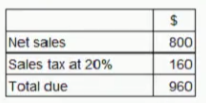CIMA BA3 - Fundamentals of financial accounting
In relation to accounting coding systems in the computerized records of an entity, which of the following is true?
An invoice to Sammy has been entered in the sales day book as $85 instead of $58.
To correct the position, which of the following procedures should be adopted?
VWX is registered for sales tax in Country B A sales invoice to its mam customer shows the following information:

What journal entry will WVX process to record this transaction in its nominal ledger?
A)

B)

C)

D)

A decrease in the allowances for receivables would result in:
Company X wants to find the total of all the transactions from its sales account. Where should Company Xlook?
ABC manufactures vehicle engines and purchases components from a supplier Each engine requires one component costing $10 each ABC's supplier otters a 5% volume discount which has always been taken, this reduces the cost to $9.50 each. However, ABC has recorded the cost as $10 throughout the accounting system
Once the correct price is recorded, what will be the effect on the factory costs incurred and the gross profit margin (GP%)?
A)

B)

C)

D)

A company has authorized capital of 100,000 5% preference shares of $2 each and 500,000 ordinary shares of $0.20p each. All of the preference shares have been issued, and 400,000 ordinary shares have been issued at $0.45p each.
Interim dividends of $0.10p per ordinary share, plus half the preference dividend have been paid during the current year. A final dividend of $0.20p per ordinary share is declared.
The total of dividends payable for the year is
Entity HJ is a small business. In the period. Entity Hj earned revenue of £24,300, had opening inventories of £1,500 and closing inventories of £8,000. Purchases came to £13,200.
What was Entity Hj's gross profit or loss for this period?
Which of the following transactions would be classified as a revenue transaction?
A company uses the straight line method of depreciation for its plant and machinery. Depreciation is at a rate of 20% per annum.
A major item of machinery was purchased in 2003 at a cost of $240,000. At the time, it was estimated that the plant had an estimated useful life of five years and a residual value at the end of its useful life of $20,000.
As a result of rapid changes in technology it was decided to sell the machinery in 2006 for $80,000. It is the company's policy to charge a full year's depreciation in the year of acquisition and none in the year of disposal.
What was the profit/loss arising on the disposal of the asset?



